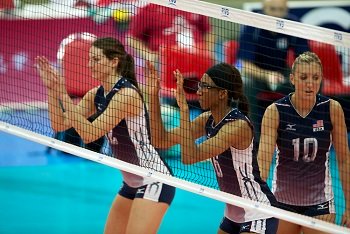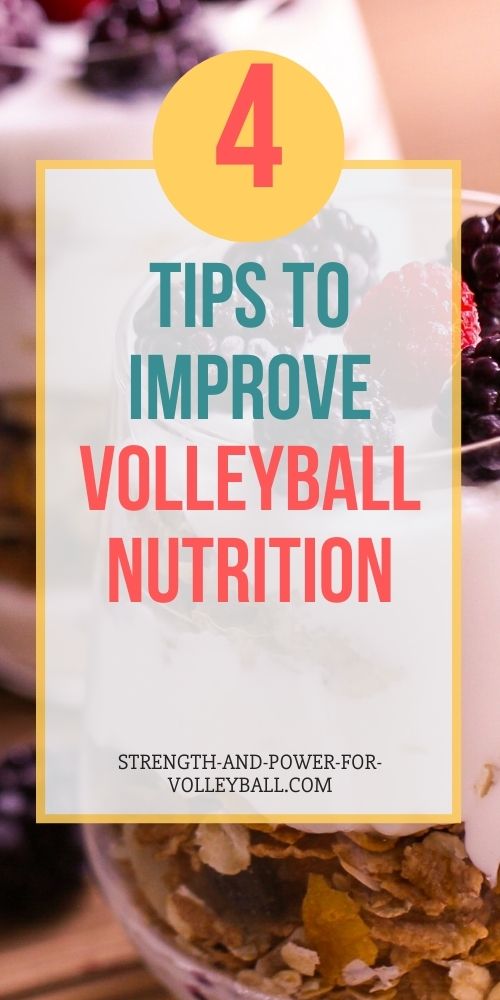Volleyball Nutrition
Guidelines for Volleyball Players
Volleyball sports nutrition tips for increasing performance.
Quick sports nutrition training tips
- Eat every two to three hours.
- Adequate amount of carbohydrates before you train.
- Drink plenty of water.
- Consume a post workout nutrition drink, shake, or snack.
Two fundamental components...
- Appropriate calorie intake
- Appropriate nutrient levels to prevent volleyball nutrition deficiencies
It's important to note that there isn't ONE right diet for athletes. Volleyball sports nutrition should be personalized to you, the sport you're training for, and possibly your culture and background.
What's important is that your body gets adequate amounts of water, vitamins, minerals, protein, carbohydrates, and fat
- these are called macronutrients.
A macronutrient is an essential nutrient required in a relatively large amount.
Three important classes of macronutrients are proteins, carbohydrates, and fats.
The best diet for a volleyball player is the one thats individualized.
Carbohydrates, Proteins, and Fats
In human physiology, the primary role of carbohydrates is to provide energy.
Diets high in carbohydrates may be beneficial to athletes because
consuming carbohydrates may increase the levels of glycogen in muscles
and provide the athlete an adequate supply of glucose or glycogen ready
to use for energy during competition.
Carbohydrates can be classified in 3 groups - monosaccharides, disaccharides, and polysaccharides.
Simple Carbohydrates
Generally, monosaccharides and disaccharides can be classified as simple carbohydrates.
Simple carbohydrates or simple sugars can be used immediately for
energy after consumption. Simple sugars are commonly referred to as
glucose. Glucose (the most common monosaccharides) dextrose and fructose
are found in many volleyball sports drinks.
Some foods that contain simple sugars are fruits, vegetables, milk, and most junk food.
Complex Carbohydrates
Generally, polysaccharides can be classified as complex carbohydrates.
Complex carbohydrates are made up of starch, fiber, and glucose.
Starch comes from the glucose in plants. Good sources of starch are grains, vegetables, nuts, and legumes.
Complex carbohydrates are significant to athletic performance because they can be used as a temporary source of stored energy.
Complex carbohydrates are simply sugars bonded together to form a chain.
Digestive enzymes have to work much harder to access the bonds to break
the chain into individual sugars for absorption through the intestines.
Complex carbohydrates are sugars that are absorb by the body much slower than simple carbohydrates.
This slow absorption provides a steady supply of energy (for example,
providing energy throughout a volleyball tournament). This slow
absorbtion also limits the amount of sugar converted to body fat.
Foods that typically provide a good source of complex carbohydrates are cereals, breads, and pastas.
Protein
Two types of proteins are complete proteins and complementary proteins.
Complete proteins are found primarily in foods from animals such as eggs, fish, meat, dairy, and poultry products.
Complementary proteins are primarily found in plant foods such as beans, rice, corn, peanuts, and bread.
Adequate protein intake is essential for
Athletes
- Muscle tissue repair
- Auxillary fuel via branched-chained amino acids
- Maintenance of a positive nitrogen balance to maximize hypertrophic stimulus (muscle growth)
Fat for Athletes
Fats behavior is related to the saturation of fatty acids.
A saturated fat is "saturated" with hydrogen atoms. In cellular
metabolism, hydrogen-carbon bonds are oxidized to produce energy.
The more double bonds in the fatty acid, the greater the degree of
unsaturation in a fatty acid and the more vulnerable it is to lipid
peroxidation.
Antioxidants can protect unsaturated fat from oxygen-dependent deterioration of lipids (lipid peroxidation).
Saturated fatty acids contain all the hydrogen they can carry. Where double bonds are formed, hydrogen atoms are eliminated.
Fatty acids that contain no double bonds are saturated fats.
Monounsaturated fats are fatty acids that contain one double bond.
Polyunsaturated fats are fatty acids that contain two or more double bonds.
Saturated fats are often referred to as bad fats because some saturated fatty acids cause an increase in LDL and HDL cholesterol.
Unsaturated fats are referred to as good fats because
monounsaturated fatty acids generally dont have an effect on
cholesterol and polyunsaturated fatty acids tend to lower HDL and LDL
cholesterol.
Fat has many healthy functions such as
- Body fat insulating and protecting organs and hormone regulation.
-
Supplying essential fatty acids (omega-6 and omega-3) necessary for
Proper function and development of the brain and nervous system
Formation of healthy cell membranes
Athletes should be careful when on low fat or no fat diets because this could lead to nutrient deficiencies.
Both fat stored in your body and circulating fatty acids are potential energy sources during athletic performance.
Generally, stored fat is used more during activity while circulating fat is more important
for recovery after the workout.
Water for Athletes
Water affects athletic performance more than any other nutrient.
Water is important for normal cell function and thermoregulation.
Most athletes only replace about two thirds the amount of water they sweat off during exercise.
Many athletes make the mistake of only drinking when they start to get
thirsty. This is a mistake because thirst is not a reliable indicator,
especially when the athlete performs intense exercise in a hot
environment.
Vitamins and Minerals
Vitamins are usually needed in small amounts to perform metabolic functions.
Minerals also provide a variety of metabolic functions.
Some Functions of Minerals
- Calcium for healthy teeth and bones, nerve transmission and muscle contraction
- Iron is important for transporting oxygen and enzymes for energy metabolism.
Calcium, iron, magnesium, phosphorus, sodium, potassium, and chloride are often referred to as the major minerals.
Electrolytes sodium, potassium, and chloride
You may be familiar with the term electrolytes from volleyball sports drinks such as Gatorade and Powerade.
Most sports drinks have a combination electrolytes (particularly sodium
and potassium) used to regulate the body to prevent dehydration and
enhance sports performance.
A disturbance in electrolyte balance will affect athletic performance, especially in hot and humid environments
so it is wise to consume electrolytes during long volleyball tournaments or
intense training sessions.
If you enjoyed these tips and would like to keep it close to you at any time, just save this pin to your Pinterest Volleyball Training Board.
Volleyball Sports Nutrition Related Pages
Pre-Tournament Meals
Food for volleyball tournaments. Learn what you need to eat the day before and day of the match. Meals for volleyball players will vary. Everyone is different.
Volleyball Tournament Nutrition
Volleyball
tournament nutrition tips, drinking plenty of water, consuming
carbohydrates, electrolytes (mainly sodium and potassium) to prevent
cramping and help muscle contraction...
Volleyball Foods
Do
you know what foods to eat for volleyball? Whether you're looking to
add on lean muscle or to lose stubborn fat, this nutrition info will
dramatically transform your health, energy, and physique.
Pre Workout Nutrition
Pre
workout nutrition is important because you need energy to train hard,
build muscle, get stronger, and recover fast from hard workouts. Not
eating before and after your training is the dumbest thing...

